Whether you are the proud owner of a famous steamer trunk or have one of the following; the Dome-topped, Flat-topped, slatted, Saratoga, Slatted, Wall, or Jenny Lind trunks, you need to know what type of trunk lock is attached to your antique trunk.
If you can’t find the key to your antique trunk and have some valuables inside, read on, this piece together for you.
Here you’ll be exposed to the different types of antique trunk locks and learn how to identify them.
Table of Contents
The History of Antique Trunk Locks
First, let’s dive in at the history of trunks locks and how they evolved.
Before the 1830s, locks for trunks were handmade. However, with industrialization came the machines, so 1836 unlocked a new era of trunk locks.
The methods used to manufacture these new era locks lasted until the 1920s, when some modifications were adopted. These modifications are still present in footlockers of today.
Generally, the most popular way for you to identify an antique trunk lock will be to examine the manufacturer’s name and patent date imprinted on the lock. By doing this, you can often determine the age of a trunk and the trunk manufacturer.
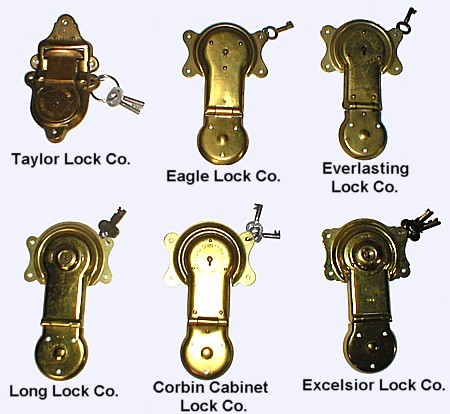
Popular trunk manufacturers of old include; names like the Eagle lock company, Yale and Towne lock company, Long Lock company, Excelsior Lock company, and a few others.
Although these were different manufacturers, the antique locks they made had a few things in common.
First, their keys were difficult to make, difficult to find, not to mention that these machine-manufactured locks for majorly steamer trunks were also complex.
Another common feature of these locks is their accompanying key. The most common three are barrel keys, corrugated keys, and flat keys.
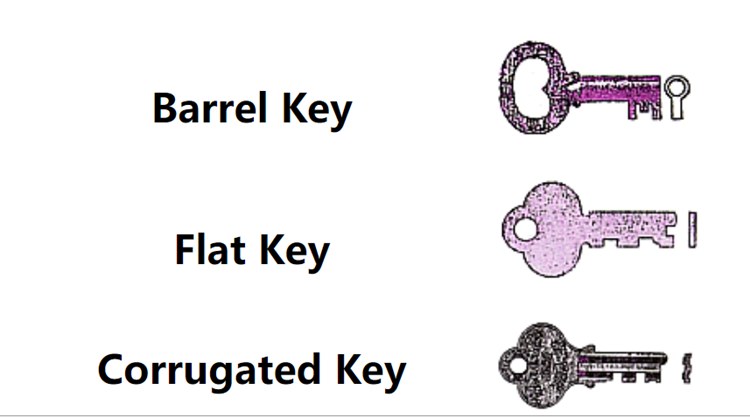
Types of Antique Trunk Locks and How to Identify Them
There are only two prevalent vintage trunk locks; the warded trunk lock and the pin tumbler trunk lock.
Let’s take a look at them, identify them, and learn how to unlock them.
Pin Tumbler Locks
Historically, the first pin tumbler locks predate to 2000BC in ancient Egypt, where locks were massive and required non-disabled men to carry the lock around. In addition, they helped keep doors closed and had brass pins in them that were designed to fall into holes.
| Egyptian Lock Mechanism | |
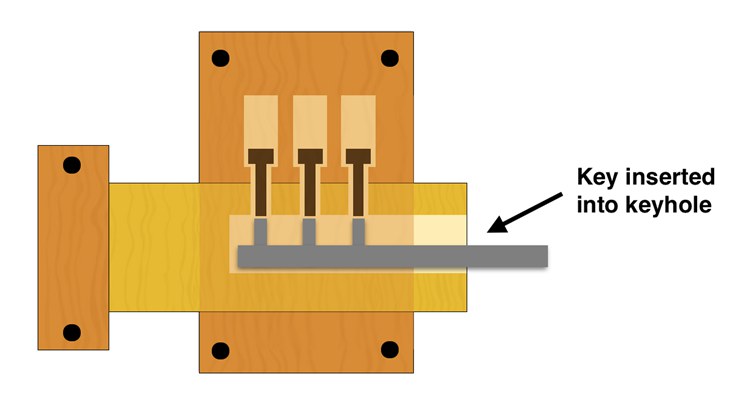 |
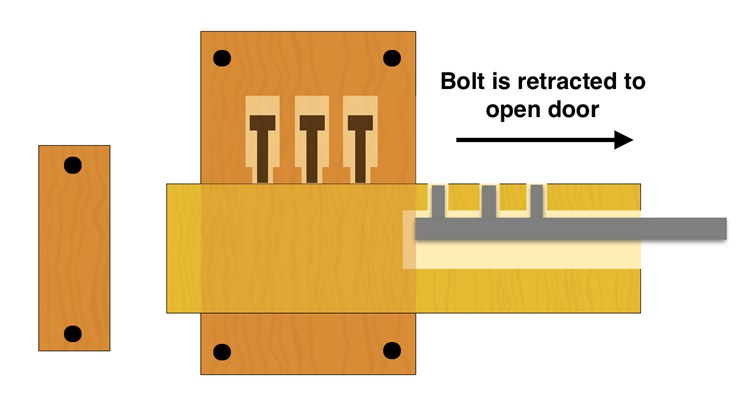 |
| The key is inserted into the lock bolt, and the pins are lifted | The key is then pulled out of the lock along with the deadbolt |
| Source:wikipedia.org | |
In 1848, Linus Yale designed the now popular modern pin tumbler locks. Although it is pretty uncommon to find pin tumbler locks attached to pin tumbler locks, it does not mean that they do not exist.
How do Pin Tumbler Locks Work?
Antique pin tumbler locks will keep your antique trunk locked unless you insert the correct key into the lock. They have horizontal blades on the key that have to align with the wards in the keyway.
The spring-loaded pins will be driven upwards once you insert the proper key with the correct notch design.
Another feature on the key is the bittings which vary in length. Each key bitting is designed to match a specific key pin.
Once the bittings match the correct key pin, the driver pins will exit the plug, clearing the shear line. With the sheer line now free of obstruction, the key can now propel the rotation of the cylinder plug, which then opens up the lock.
Easy Ways to Identify an Antique Pin Tumbler Lock
When you need to identify if the lock on your antique trunk is a pin tumbler lock, follow these easy steps
Method 1: Examine the Key
If you have the key to your antique pin tumbler lock with you, by simply examining the key, you will be able to decipher if the lock is a pin tumbler lock. The key comprises four parts: the blade, the shoulder, the head, and the biting.
The bitting or groves are the most distinguishing feature here. They are grooves and dips that extend to the shoulder of the key. These grooves and dips stop at the shoulders to prevent the key from over inserting.
Method 2: Check for Presence of Pins Inside the Keyhole
Another way to identify a tumbler lock is through the presence of pins in the keyhole. By simply shining a source of light into the keyhole, you would see these pins.
How to Open a Pin Tumbler Lock
Without any prior lock picking experience, it will be almost impossible to pick a pin tumbler lock. If you have an idea of picking locks, we recommend you stick to the raking method instead of single-pin picking.
This method is more straightforward, and with the proper lock picking tools, a tension wrench, and luck, you might be able to get past the lock’s security. If not, we advise you to contact a professional lock picker.
Warded Antique Trunk Lock
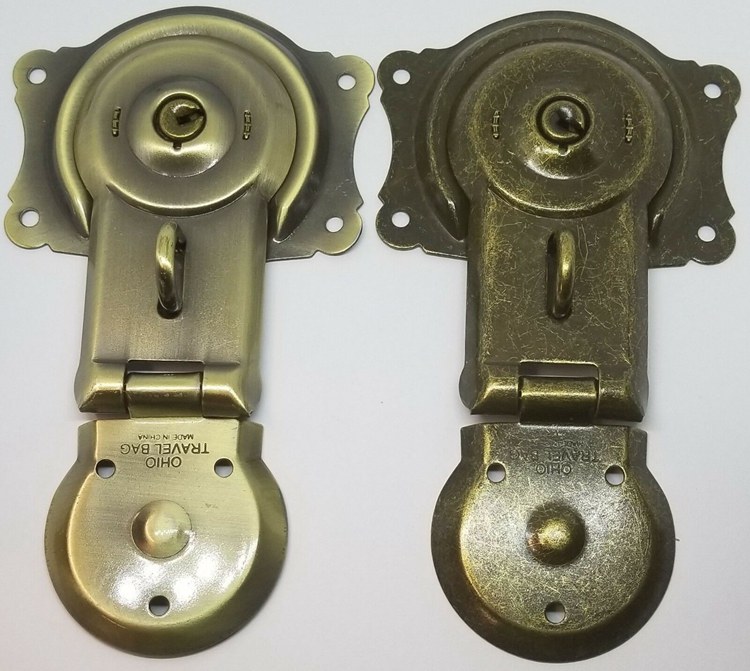
The warded antique trunk lock is the more popular type of trunk lock. Even today, this lock is still quite popular. But, unfortunately, today, these locks are most times mistaken for lever locks.
History shows that these warded locks were found to be manufactured several years after pin tumbler locks and sliding bolt locks came into existence. And like the name states, these locks featured obstructions or wards that kept valuables.
Additionally, with the creation of warded locks came the development of skeleton keys designed to open multiple locks. These skeleton keys had short notches and were what gave rise to the idea of the now popular master key.
How do Warded Trunk Locks Work?
How do these warden locks work?
Well, it’s pretty simple. As we previously mentioned, often, you’ll find that warded trunk lock consists of a set of obstructions, each having a concentric plate that protrudes out of it. If a key isn’t designed for that lock, the key will not be able to rotate.
The lock inhibits the rotation of the wrong keys. A warded trunk lock key will also find it difficult to slide into the wrong lock.
In the right lock, however, the correct key will slide in without any troubles. The wards of the lock then align perfectly with the key’s grooves, granting or denying entry to the locked cylinder.
Ways To Identify a Warded Trunk Lock?
Here are some methods to follow to confirm if the lock on your antique trunk is a warded lock.
Method 1: Examine the Keys to the Lock
One sure way to identify whether a lock is a warded trunk lock is to examine the grooves on the key to the lock. If you notice that the grooves are rectangular with a round shaft, you may be dealing with a warded trunk lock.
Additionally, you’ll notice that the key to your warded lock will be flat.
Method 2: Examine the Keyhole
Once you take a look inside the keyhole of a warded trunk lock, unlike the pin tumbler locks where you’ll immediately see some pins, here the space will be open with little or no obstruction.
How to Open an Antique Warded Trunk Lock
Opening a warded lock is possible if you have the required lock picking mechanism. With a skeleton key picking the warden lock on your warded trunk is even easier.
As stated earlier, warded keys have notches designed to keep the wrong key from entering the interior wards. These skeleton keys are specifically designed to be able to go past these internal wards.
Once you insert a skeleton key or lock pick, leave only the last or last two notches to stick out. With this, you should be able to bypass the lock’s security with only a few twists.
Conclusion
If you are about to purchase an antique trunk lock, you need to ensure you are getting your money’s worth. This means you don’t want to end up paying for an original and end up getting a reproduction. Here are some tell signs;
- One sure way to identify authentic antiques from reproduced ones is to check the lock for signs of aging.
- Another way to examine an antique is to check for irregularities. For example, a reproduced antique will look a little too perfectly old-looking. In contrast, an authentic antique will have sides that are slightly off-color.






![Vintage Schwinn Bikes: [Types, Identification, and Values]](https://www.txantiquemall.com/wp-content/uploads/2022/05/5.-Schwinn-1967-Ramshorn-Fastback-Stingray-Sky-Blue-vtg-600x450.jpg)

I have a dome top trunk with a double latch lock. I do not have the key. I know the inside of the barrel is larger than 1/8”. So you know what keys were made for these trunks?